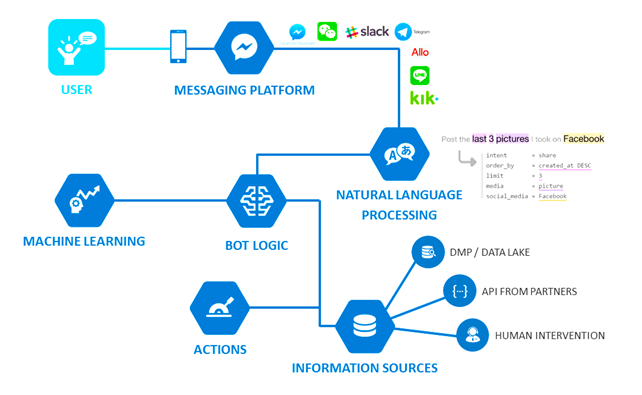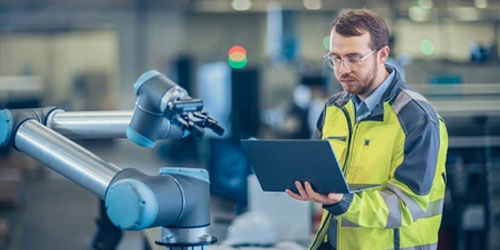Innovations have infused businesses with more opportunities, and every aspect of a business is now quite simple. In the wait-for-none era that is persistent now, everybody likes to collaborate and expect quick answers without much delay. The fast-growing world of AI has consumers getting technological help in all facets of their lives and virtual chatbots that imitate human conversations are becoming increasingly predominant. Chatbots are computer programs designed to simulate human conversations, powered by set rules and sometimes AI, which users can interact with on a standard chat interface. Chatbots rely on machine learning and deep learning to engage in a two-way conversation that enhances customer engagement. They can be easily programmed to handle standardized, repetitive tasks and are increasingly replacing the need to have a human marketer conversing with a consumer. The use of natural language processing ensures that the conversation feels natural and intuitive to the end user.
There are two broad classifications of chatbots – Rule-based and Machine Learning-based. Rule-based chatbots take input from the customer and check the rules that have been defined giving a pre-programmed response. Chatbots based on machine learning understand the context of and intent behind an input before formulating a corresponding response to it.
Explaining technologies that power a Chatbot
A smart chatbot is created through a combination of artificial intelligence, machine learning, and language handling with a few simple strategies, contents, chat logs, evaluations, and altering reactions in the talk logs. Chatbots are not intelligent by default but are prepared to demonstrate extreme levels of intelligence by utilizing technologies. Programming languages are used to build a web API. The back-end gets messages, thinks about a reply, and returns it to the client. The front-end may be one of the messenger apps or a chat interface, and the web server connects the back-end and front-end. Finding the right mix of tools to build a chatbot is challenging.
A basic essential combination has the following included:
Natural language processing — decomposing input sentences into the constituent parts.
Query generation — translating parsed sentences into valid queries.
Context management — remembering the results of previous queries to answer futures ones intelligently.

Domain knowledge — storing knowledge about the domain of the chatbot’s expertise.
Natural language generation — giving the chatbot a personality.
Once the chatbot is ready and live interacting with customers, smart feedback loops can be implemented. Chatbots can go far to improve the responsiveness and efficiency of an organization’s customer service.
A conversational Bot, powered by Artificial Intelligence significantly improves the conversational experience, allowing natural conversation between the Bot and the end user. Instead of the end user having to learn a fixed set of keywords that the bot will respond to, a conversational Bot understands the user’s intention and reacts accordingly. The AI-powered intent detection is combined with a sophisticated state machine that maintains the context of the conversation and allows to define the appropriate conversational flows and sub-flows, and how to properly respond to the end user. Conversational Bots ensure that the users come back to use the service due to the personalized experience.
A predominant worry is that the bot might not understand the intent of the customer. Before going live, the bots are first trained with the actual data. Most organization’s that have a chatbot generally have logs of conversations. Developers use these logs to analyze what customers are trying to ask and what it implies. With a combination of Machine Learning models and tools built, developers match questions that customers ask and provide the most suitable answer. A developer’s strength lies in training the models so that the chatbot can connect questions to the correct intent and produce the correct answer as the output. Chatbots are great at retrieving information, even from unstructured sources. In instances where there is no extensive data available, different APIs data are used to train the chatbot.
Advantage Chatbots
- Prompt responses to customers — chatbots can work as fast or as slow as desired. Without the need to think and type, chatbots can respond instantly. Chatbots save time and efforts by automating customer support, and Gartner forecasts that by 2020, over 85% of customer interactions will be handled without a human.
- Cost effective — Chatbots are more cost-effective for large volume queries than customer care agents. Even with complex questions, a chatbot is the most cost-effective in development, deployment, maintenance and support costs, given higher volumes.
- 24X7 support — Chatbots do not need a break and work all through.
- Improved response quality — Trivial queries being handled by a chatbot, other questions can be handled by the most experienced and helpful employees.
- Good analytics — With its ability to understand natural language and codify it, chatbots can provide a vast swath of information about customers that can be used everywhere from product development to cost reduction.
The opportunities provided by chatbot systems go far beyond just giving responses to customers’ inquiries. They are also used for many other business tasks, like collecting information about users, helping to organize meetings and reducing overhead cost. Competitive advantage is difficult to sustain and simply adopting this new technology may not be enough. When appropriately applied, chatbots are the most compétitive differentiator in an area where technology doesn’t always generally fare well – customer service.
YASH Chatbot
End users by human nature potentially branch off into different states and context in the course of a
Conversations. They might switch between checking an account balance to making a payment or even checking for their most recent transactions. There are numerous chat and voice channels with different integration interfaces. Our chatbots provide an easy way to construct a context-aware conversational dialog with the end user by using Virtual Private Assistants (VPA) like Amazon’s Alexa and also Voice interfaces like Microsoft’s Cortana. This not only reduces the speed at which they can deploy but also the total cost of ownership.
Our multilingual Chatbots are developed using advanced ML techniques and redirect all customer inputs to an on-premise or a cloud-based deep learning network to answer thousands of questions simultaneously with responses specific to each query. This enables our Chatbot to give real-time responses and address customer queries extremely efficiently. Get in touch with us today to determine the scope of the problem that can be addressed and we will help you choose an effective platform to run the bot by understanding your business needs and identifying the right type of chatbot to serve your purpose and give you a competitive edge.
Hemanth Kanakagiri- Solution Architect @YASH Technologies
Reference: http://cloud.oracle.com


















